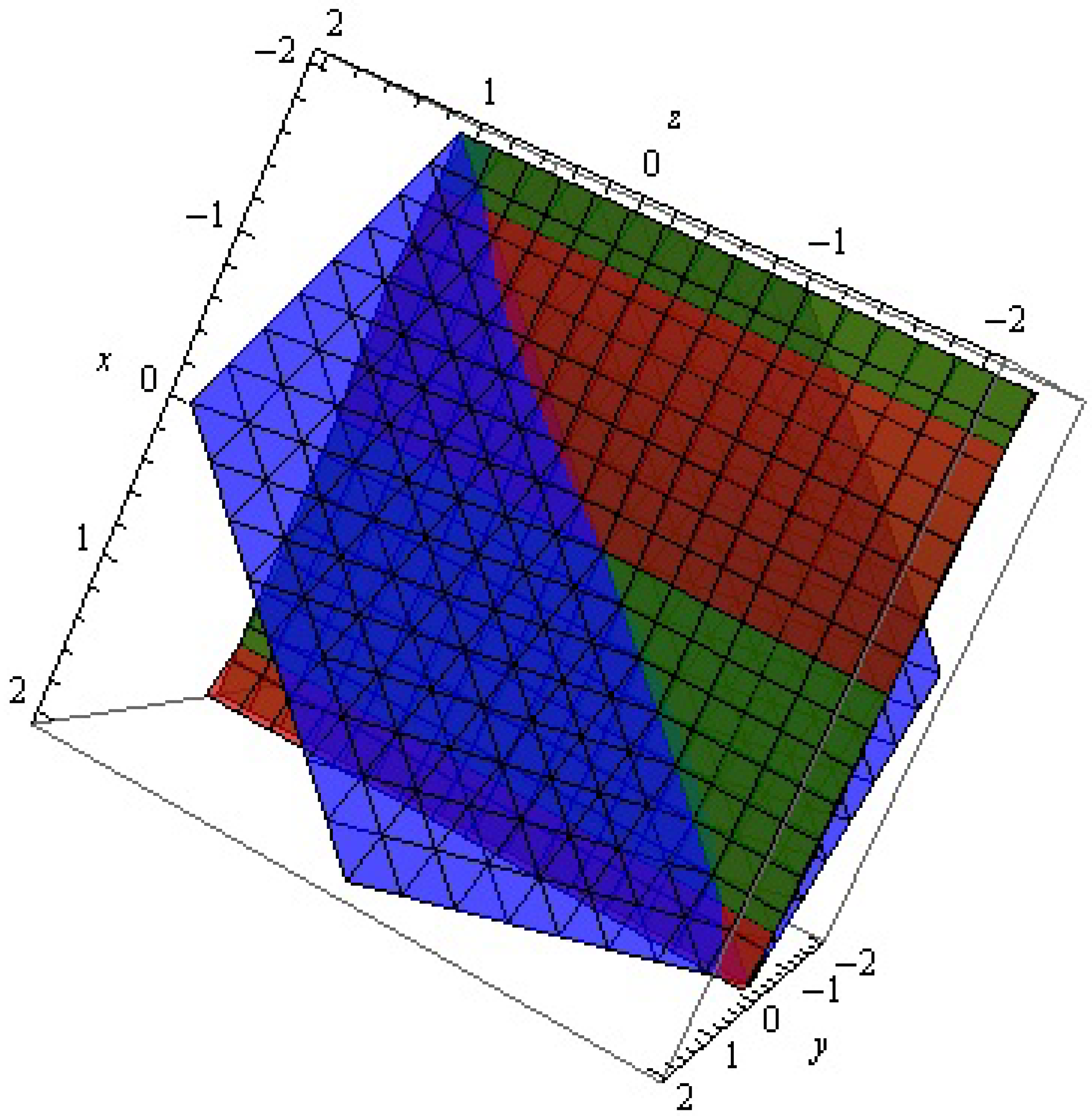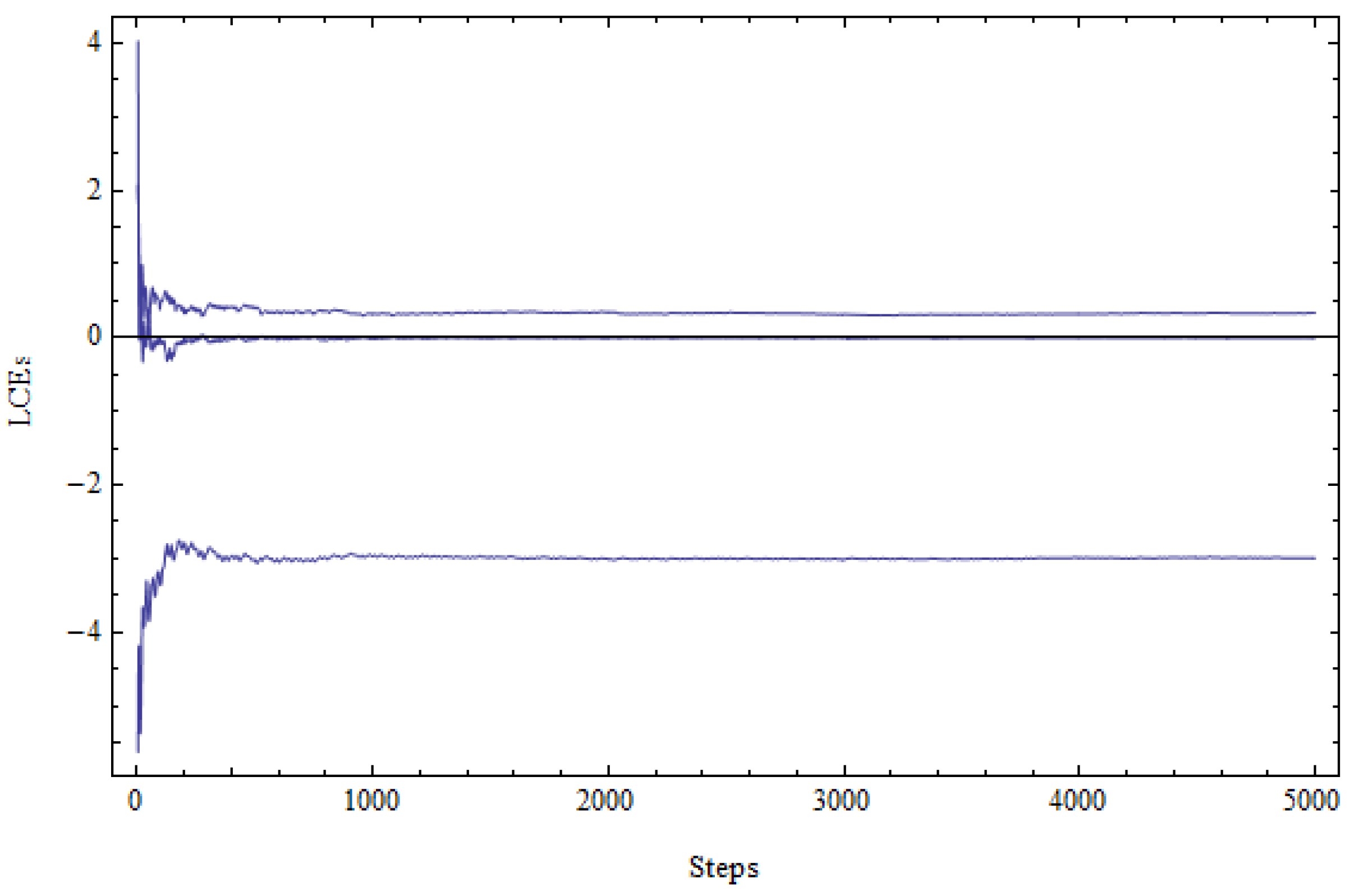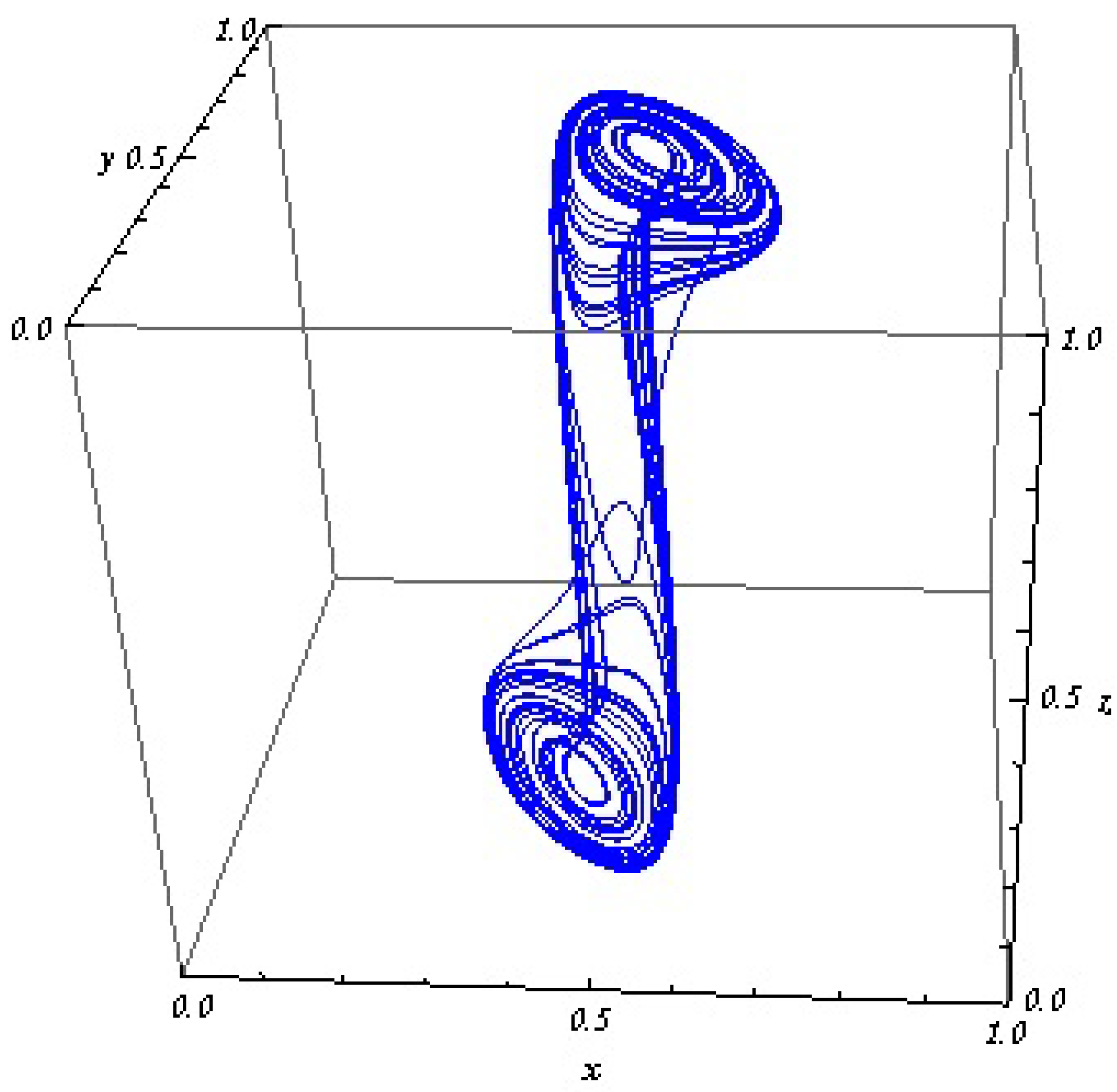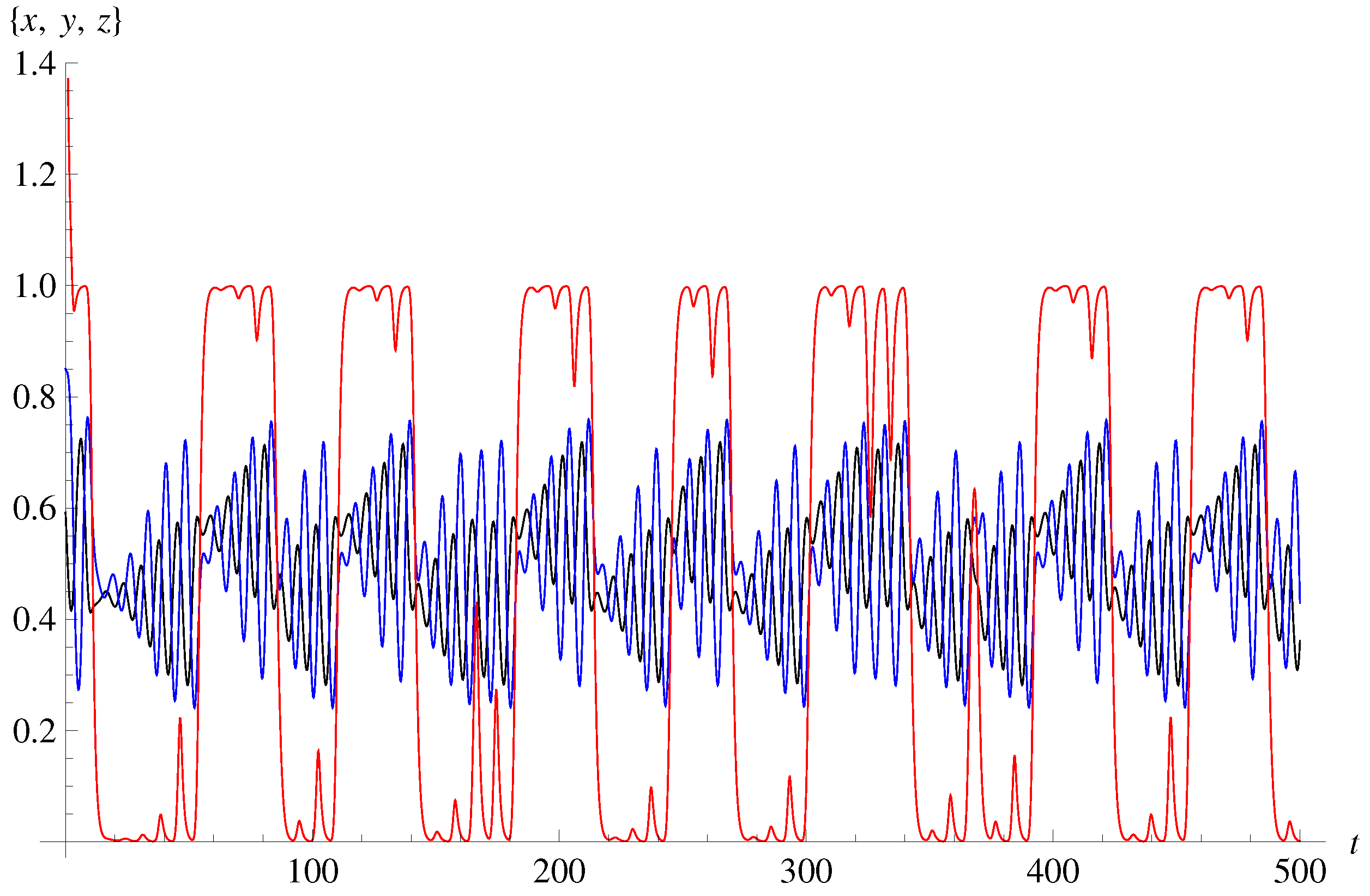A New 3D Chaotic Attractor in Gene Regulatory Network
Abstract
1. Introduction
- chaotic behavior is characterized by the presence of an attractor to which all nearby solutions tend to converge over time, provided there is ample time for the process [19];
- a common feature of chaotic solutions lies in the geometric structure of their attractors. These attractors often exhibit intricate and unconventional shapes, characterized by a twisted and “strange” appearance. This strangeness is indicative of a fractional (fractal) dimension, although it’s important to note that this isn’t always the case [19];
- sensitivity to initial conditions [18].
- formulas for characteristic numbers of critical points for three-dimensional systems were considered;
- the new chaotic attractor is obtained;
- the three-dimensional system (7) can have attractors of various kinds;
- the irregular behavior of solutions near the chaotic attractor is conceivable and may manifest within a narrow parameter range.
2. Materials and Methods
2.1. Chua Circuit
2.2. 3D Gene Regulatory System
- —degradation of the i-th gene expression product;
- —the connection weight or strength of control of gene j on gene i. Positive values of signify activating influences, whereas negative values denote repressing influences;
- —The impact of external stimuli on gene i is reflected in its ability to modulate the gene’s responsiveness to activating or repressing factors [31].
2.3. Linearized System
3. Results
3.1. 3D Chaotic Attractor
3.2. Bifurcation
4. Discussion
Author Contributions
Funding
Data Availability Statement
Conflicts of Interest
Abbreviations
| GRN | Gene regulatory network |
References
- Ramar, R. Design of a New Chaotic System with Sine Function: Dynamic Analysis and Offset Boosting Control. Chaos Theory Appl. 2023, 5, 118–126. [Google Scholar] [CrossRef]
- Mansour, M.; Donmez, T.B.; Kutlu, M.C.; Freeman, C. Respiratory Diseases Prediction from a Novel Chaotic System. Chaos Theory Appl. 2023, 5, 20–26. [Google Scholar] [CrossRef]
- Keles, Z.; Sonugur, G.; Alcn, M. The Modeling of the Rucklidge Chaotic System with Artificial Neural Networks. Chaos Theory Appl. 2023, 5, 59–64. [Google Scholar] [CrossRef]
- Jorgensen, S.E. Encyclopedia of Ecology; Elsevier: Amsterdam, The Netherlands, 2008. [Google Scholar]
- Ibrahim, K.M.; Jamal, R.K.; Ali, F.H. Chaotic behaviour of the Rossler model and its analysis by using bifurcations of limit cycles and chaotic attractors. J. Phys. Conf. Ser. 2018, 1003, 012099. [Google Scholar] [CrossRef]
- Xiyin, L.; Guoyuan, Q. Mechanical analysis of Chen chaotic system. Chaos Solitons Fractals 2017, 98, 173–177. [Google Scholar] [CrossRef]
- Lu, J.; Chen, G.; Guoyuan, Q. A new chaotic attractor coined. Int. J. Bifurc. Chaos 2002, 12, 659–661. [Google Scholar] [CrossRef]
- Mota, M.C.; Oliveira., R.D.S.; Qi, G. Dynamic aspects of Sprott BC chaotic system. Discret. Contin. Syst. 2021, 26, 1653–1673. [Google Scholar] [CrossRef]
- Kazuyuki, A. Chaos and Its Applications. Procedia IUTAM 2012, 5, 199–203. [Google Scholar] [CrossRef]
- Ott, E. Chaos in Dynamical Systems, 2nd ed.; Cambridge University Press: London, UK, 2002. [Google Scholar] [CrossRef]
- Feier, S. The Chaos Theory and its Application. J. Phys. Conf. Ser. 2012, 012118, 2021. [Google Scholar]
- Klioutchnikov, I.; Sigova, M.; Beizerov, N. Chaos Theory in Finance. Procedia Comput. Sci. 2017, 2017, 368–375. [Google Scholar] [CrossRef]
- Biswas, H.R.; Hasan, M.M.; Bala, S.K. Chaos theory and its applications in our real life. Barishal Univ. J. 2018, 5, 123–140. [Google Scholar]
- Joan, P.; Dandoy, R. Chaos theory and its application in political science. In Proceedings of the IPSA World Congress, Fukuoka, Japan, 9–13 July 2006. [Google Scholar]
- May, M.R. Chaos and the dynamics of biological populations. Nucl. Proc. Suppl. 1987, 2, 225–245. [Google Scholar] [CrossRef]
- Zang, X.; Iqbal, S.; Zhu, Y.; Liu, X.; Zhao, J. Applications of Chaotic Dynamics in Robotics. Int. J. Adv. Robot. 2016, 13. [Google Scholar] [CrossRef]
- Rana, S.M.S. Bifurcation Analysis and 0–1 Chaos Test of a Discrete T System. Chaos Theory Appl. 2023, 5, 90–104. [Google Scholar] [CrossRef]
- Lynch, S.E. Dynamical Systems with Applications Using Mathematica; Springer: Cham, Switzerland, 2017. [Google Scholar]
- Hastings, A.; Hom, C.L.; Ellner, S.; Turchin, P.; Godfray, H.C.J. Chaos in Ecology: Is Mother Nature a Strange Attractor? Annu. Rev. Ecol. Syst. 1993, 24, 1–33. [Google Scholar] [CrossRef]
- Samuilik, I.; Sadyrbaev, F.; Ogorelova, D. Comparative Analysis of Models of Gene and Neural Networks. Contemp. Math. 2023, 4, 217–229. [Google Scholar] [CrossRef]
- Bugajevskij, M.; Ponomarenko, V. Study of Chua Circuit Behavior; Fundamental and Comparative Research; Saratov State University: Saratov, Russia, 1999. [Google Scholar]
- Pavlov, A.N. Study of Chua Generator Dynamics Modes; Saratov State University: Saratov, Russia, 2006; pp. 1–13. [Google Scholar]
- Syed Ali, M.; Vadivel, R. Decentralized Event-Triggered Exponential Stability for Uncertain Delayed Genetic Regulatory Networks with Markov Jump Parameters and Distributed Delays. Neural Process. Lett. 2018, 47, 1219–1252. [Google Scholar] [CrossRef]
- Hoover, W.G.; Tull, C.G.; Posch, H. Negative Lyapunov exponents for dissipative systems. Phys. Lett. A 1998, 131, 211–215. [Google Scholar] [CrossRef]
- Magnitskii, N.A. Universal Bifurcation Chaos Theory and Its New Applications. Mathematics 2023, 11, 2536. [Google Scholar] [CrossRef]
- Magnitskii, N.A. Bifurcation Theory of Dynamical Chaos. In Chaos Theory; IntechOpen: Rijeka, Croatia, 2018. [Google Scholar]
- Software. Available online: www.msandri.it/soft.html (accessed on 21 September 2023).
- Wang, J.; Dong, C.; Li, H. A New Variable-Boostable 3D Chaotic System with Hidden and Coexisting Attractors: Dynamical Analysis, Periodic Orbit Coding, Circuit Simulation, and Synchronization. Fractal Fract. 2022, 6, 740. [Google Scholar] [CrossRef]
- Sayed, W.S.; Radwan, A.G.; Fahmy, H.A.A. Chaos and Bifurcation in Controllable Jerk-Based chaotic Attractors. In Nonlinear Dynamical Systems with chaotic and Hidden Attractors; Springer: Cham, Switzerland, 2018; pp. 45–70. [Google Scholar]
- Nikolov, S.; Nedkova, N. Gyrostat Model Regular And Chaotic Behavior. J. Theor. Appl. Mech. 2015, 45, 15–30. [Google Scholar] [CrossRef][Green Version]
- Vijesh, N.; Kumar, S.; Sreekumar, C.J. Modelling three dimensional gene regulatory networks. WSEAS Trans. Syst. Control 2021, 16, 755–763. [Google Scholar] [CrossRef]
- Ogorelova, D.; Sadyrbaev, F.; Samuilik, I. On Targeted Control over Trajectories of Dynamical Systems Arising in Models of Complex Networks. Mathematics 2023, 11, 2206. [Google Scholar] [CrossRef]
- Samuilik, I.; Sadyrbaev, F. On trajectories of a system modeling evolution of genetic networks. Math. Biosci. Eng. 2023, 20, 2232–2242. [Google Scholar] [CrossRef]
- Vijesh, N.; Chakrabarti, S.; Sreekumar, J. Modeling of gene regulatory networks: A review. J. Biomed. Sci. Eng. 2013, 6, 223–231. [Google Scholar] [CrossRef]
- Kozlovska, O.; Sadyrbaev, F. On attractors in systems of ordinary differential equations arising in models of genetic networks. Vibroeng. Procedia 2023, 49, 136–140. [Google Scholar] [CrossRef]
- Magnitskii, N.A.; Sidorov, S.V. New Methods for Chaotic Dynamics; World Scientific: Singapore, 2006; pp. 1–384. [Google Scholar] [CrossRef]









| The Critical Point | |||
|---|---|---|---|
| −4.3563 | 0.1782 − 3.1315 i | 0.1782 + 3.1315 i | |
| 2.4730 | −0.9865 − 2.7734 i | −0.9865 − 2.7734 i | |
| −4.3563 | 0.1782 − 3.1315 i | 0.1782 + 3.1315 i |
| The Critical Point | A | B | C |
|---|---|---|---|
| −0.725248 | −0.557956 | −0.787449 | |
| 1.2388 | 0.195983 | 1.59353 | |
| −0.725248 | −0.557956 | −0.787449 |
| The Critical Point | |||
|---|---|---|---|
| −0.9780 | 0.12638 − 0.888361 i | 0.12638 + 0.888361 i | |
| 1.82477 | −0.292985 − 0.887376 i | −0.292985 + 0.887376 i | |
| −0.9780 | 0.12638 − 0.888361 i | 0.12638 + 0.888361 i |
| −0.569 | (0.2673, 0.6735, 0.00002) | −0.9998 | −0.0051 − 0.6838 i | −0.0051 − 0.6838 i |
| (0.5, 0.5, 0.5) | 2.0836 | −0.4224 − 1.2107 i | −0.4224 + 1.2107 i | |
| (0.7327, 0.3265, 0.99998) | −0.9998 | −0.0051 − 0.6838 i | −0.0051 + 0.6838 i | |
| −0.5 | (0.3190, 0.6015, 0.0001) | −0.9990 | 0.0849 − 0.7646 i | 0.0849 + 0.7646 i |
| (0.5, 0.5, 0.5) | −0.3913 | −0.3913 − 1.1361 | −0.3913 + 1.1361 | |
| (0.6810, 0.3985, 0.9999) | −0.9990 | 0.0849 − 0.7646 i | 0.0849 + 0.7646 i | |
| −0.4 | (0.3885, 0.5144, 0.0007) | −0.9941 | 0.1319 − 0.8505 i | 0.1319 + 0.8505 i |
| (0.5, 0.5, 0.5) | 1.9197 | −0.3404 − 1.0104 i | −0.3404 + 1.0104 i | |
| (0.6115, 0.4856, 0.9993) | −0.9941 | 0.1319 − 0.8505 i | 0.1319 + 0.8505 i | |
| −0.3 | (0.4521, 0.4406, 0.0046) | −0.9698 | 0.1214 − 0.8932 i | 0.1214 + 0.8932 i |
| (0.5, 0.5, 0.5) | 1.7985 | −0.2799 − 0.8520 i | −0.2799 + 0.8520 i | |
| (0.5479, 0.5594, 0.9954) | −0.9698 | 0.1214 − 0.8932 i | 0.1214 + 0.8932 i | |
| −0.241 | (0.4873, 0.4023, 0.0133) | −0.9247 | 0.1061 − 0.8937 i | 0.1061 + 0.8937 i |
| (0.5, 0.5, 0.5) | 1.7130 | −0.2371 − 0.7312 i | −0.2371 + 0.7312 i | |
| (0.5127, 0.5977, 0.9868) | −0.9247 | 0.1061 − 0.8937 i | 0.1061 + 0.8937 i | |
| −0.24 | (0.4879, 0.4017, 0.0135) | −0.9235 | 0.1059 − 0.8935 i | 0.1059 + 0.8935 i |
| (0.5, 0.5, 0.5) | 1.7114 | −0.2363 − 0.7289 i | −0.2363 + 0.7289 i | |
| (0.5121, 0.5983, 0.9865) | −0.9235 | 0.1059 − 0.8935 i | 0.1059 + 0.8935 i | |
| 0 | (0.5, 0.5, 0.5) | −0.7071 | 0.9729 − 0.3612 i | 0.9729 + 0.3612 i |
| 8 | (0.5, 0.5, 0.5) | −3.7550 | 2.4969 − 3.1062 i | 2.4969 + 3.1062 i |
| −0.0106 | −0.0149 | −0.9997 | |
| −0.00002 | −0.1529 | −0.9907 | |
| 0.0026 | −0.2235 | −0.8975 | |
| 0.0309 | −0.0127 | −0.7389 | |
| 0.0512 | −0.0062 | −0.6901 | |
| 0.0020 | −0.0260 | −0.7109 | |
| 0 | −0.0029 | −0.6131 | −0.9340 |
| 8 | 0.0016 | −0.9139 | −1.5327 |
Disclaimer/Publisher’s Note: The statements, opinions and data contained in all publications are solely those of the individual author(s) and contributor(s) and not of MDPI and/or the editor(s). MDPI and/or the editor(s) disclaim responsibility for any injury to people or property resulting from any ideas, methods, instructions or products referred to in the content. |
© 2023 by the authors. Licensee MDPI, Basel, Switzerland. This article is an open access article distributed under the terms and conditions of the Creative Commons Attribution (CC BY) license (https://creativecommons.org/licenses/by/4.0/).
Share and Cite
Kozlovska, O.; Sadyrbaev, F.; Samuilik, I. A New 3D Chaotic Attractor in Gene Regulatory Network. Mathematics 2024, 12, 100. https://doi.org/10.3390/math12010100
Kozlovska O, Sadyrbaev F, Samuilik I. A New 3D Chaotic Attractor in Gene Regulatory Network. Mathematics. 2024; 12(1):100. https://doi.org/10.3390/math12010100
Chicago/Turabian StyleKozlovska, Olga, Felix Sadyrbaev, and Inna Samuilik. 2024. "A New 3D Chaotic Attractor in Gene Regulatory Network" Mathematics 12, no. 1: 100. https://doi.org/10.3390/math12010100
APA StyleKozlovska, O., Sadyrbaev, F., & Samuilik, I. (2024). A New 3D Chaotic Attractor in Gene Regulatory Network. Mathematics, 12(1), 100. https://doi.org/10.3390/math12010100
















